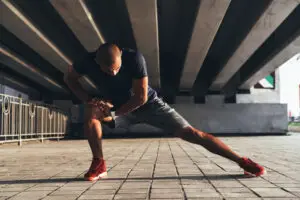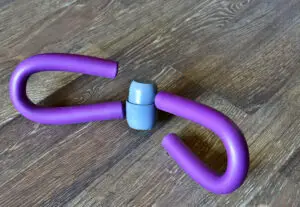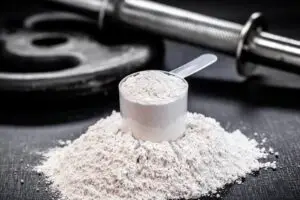The partial squat takes some of the difficulty out of the traditional squat. While the full version can be a bit intimidating, you can get some of the same benefits with the partial squat. Let’s talk about how to do this variation and what makes it different from the squat we all know and kind of love.
What Is a Partial Squat?
The half squat or partial squat is almost identical to a regular squat, except you don’t go down quite as far into the squatting position. You stop around halfway there, at about a 125-degree angle.
By not going down into a full squat, you save yourself some time and a whole lot of effort. It’s a low intensity version of the popular exercise, and you can do it with some of the same variations you would use on a full squat. That would include modifications with weights, as well as the sumo squat and single leg squat.
What does a partial squat do that a regular squat can’t? It makes squats accessible so that more people can do them and not feel winded after a single rep. It’s easier to get through a full set.
Are Partial Squats Beneficial?
Even though you are not going through the full motion for the squat, you can still enjoy some benefits from doing partial squats. Your workout gains won’t be as significant as if you were doing full squats, but the benefits of a partial squat still make them worth using.
These squats are great confidence builders. By doing the partial squats, you can build up the strength you need to do full squats and feel good about your workout. It’s good to know you can do some kind of squat, even if the full squat is a bit too difficult at this point for you.
You can use them in conjunction with full squats to take those squats further and add more to your workout. They also can help you to improve your athletic performance, giving you the ability to do more and reach the goals you have set for yourself. They improve your ability to jump as well, giving you the power to jump further and higher as you do this exercise more.
Partial squats are a good way to add some muscle mass on the lower half of your body, working those muscles so you can do more and go further in later workout sessions.
Are Half Squats Better than Full Squats?
There are some reasons to do half squats instead of full squats, even if you could easily do either one.
The half squat is a great way to target the glutes, as it builds up the glutes even better than full squats do. You can shape your rear quickly and effectively with this exercise without having to do the extensive exertion of the full squat.
They are also better than full squats for people who have difficulty with balance or who don’t have the strength to do the full squat very easily. It may be advantageous for you to do the partial squat because it won’t wear you out as much. That means you could work out for longer and get more out of your workout.
What Muscles Does a Partial Squat Work?
You are primarily working your lower body with partial squats, building up key muscles there so that full squats are easier to do as well as other activities and exercises that rely on lower body strength.
Specifically, partial squats strengthen the glutes and quads, as well as all the other lower body muscle groups. You get a full lower body workout with this exercise, so you should not feel bad about incorporating them into your workout.
These are the muscles you will use for jumping, running, squatting, and more. By strengthening these areas of the body, you will improve your balance and stability and reduce the risk of injury to your lower body as you do activities that can tax it.
Are Partial Squats Safe?
These can be quite safe if you are doing them correctly. You just need to keep your form right, and the key part of the body to watch is your back. You don’t want to put undue strain there during your partial squats.
Your back should be inclined as you do this exercise and not kept straight. That reduces the load on your lower back in particular. If you are lifting while doing partial squats, the load you are pressing can be really harmful to your back, so make sure the form is right in that key area. You can further protect yourself by wearing a weightlifting belt.
You should warm up ahead of your workout to limber up your muscles and ensure that all the equipment you are using is set to the right levels and is working properly. Also use a spotter to help you out of any tight spots.
Difference between Partial Squat and Full Squat
The primary difference between these two types of squats is how far down you go when you descend into the squat. The partial squat only requires you to bend down half the distance for the full squat.
That means that the squat affects your body in different ways. The partial squat will work some different muscles compared to the full squat. We talked about those earlier, and the full squat is focused on the quads more, whereas the partial squats target the glutes primarily.
The partial squat does not require as much strength, so the gains are not as great as they would be with the full squat. That makes them ideal for heavy weightlifting exercises, because you can lift more if more of your strength is focused in your arms and shoulders. The full squat requires more from you, so it may be harder to lift as big of a load as you could with a partial squat.
Pros and Cons of Partial Squat
We have had both good and bad things to say about partial squats throughout this article, but let’s lay them out for you so you can see them all listed together and decide if you want to use partial squats in your workouts.
Pros:
- easier to do than full squats
- builds confidence and strength well for beginners
- better than full squats for heavy weightlifting
- not very hard on your body
- great glute builder
Cons:
- gains are less than full squats
- can give you false confidence and false strength assessment
- not as good for working your quads as full squats
So, there you have everything you should need to know about partial squats. These can be good exercises to bring into your weight lifting regimen or weight loss workout, but you may want to mix them up with full squats so that you get more benefits.
My name is Ellis Francis and I have been a personal fitness trainer, sports nutritionalist and health and fitness advisor for over 25 years. I am the lead health and fitness advisor at https://awellnessbody.com.







